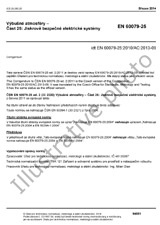We need your consent to use the individual data so that you can see information about your interests, among other things. Click "OK" to give your consent.

IEEE C62.59-2019
IEEE Standard for Test Methods and Preferred Values for Silicon PN-Junction Clamping Diodes
Translate name
STANDARD published on 31.10.2019
The information about the standard:
Designation standards: IEEE C62.59-2019
Publication date standards: 31.10.2019
SKU: NS-974480
The number of pages: 41
Approximate weight : 123 g (0.27 lbs)
Country: International technical standard
Category: Technical standards IEEE
Annotation of standard text IEEE C62.59-2019 :
New IEEE Standard - Active.
Supersedes IEEE C62.35-2010 and IEEE C62.35-2010/Cor1-2018. The basic electrical parameters to be met by silicon PN junction voltage clamping components used for the protection of telecommunications equipment or lines from surges are defined in this standard. It is intended that this standard be used for the harmonization of existing or future specifications issued by PN diode surge protective component manufacturers, telecommunication equipment manufacturers, administrations, or network operators.
ISBN: 978-1-5044-6119-1, 978-1-5044-6120-7
Number of Pages: 41
Product Code: STD23860, STDPD23860
Keywords: avalanche breakdown, electrical characteristics, electrical ratings, foldback, forward conduction, IEEE C62.59, overvoltage protection, punch-through, surge protective component (SPC), test methods, Zener breakdown
Category: Surge-Protective Devices
We recommend:
Technical standards updating
Do you want to make sure you use only the valid technical standards?
We can offer you a solution which will provide you a monthly overview concerning the updating of standards which you use.
Would you like to know more? Look at this page.



 Cookies
Cookies
